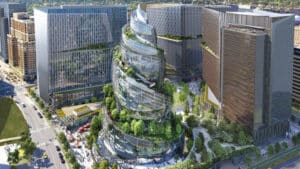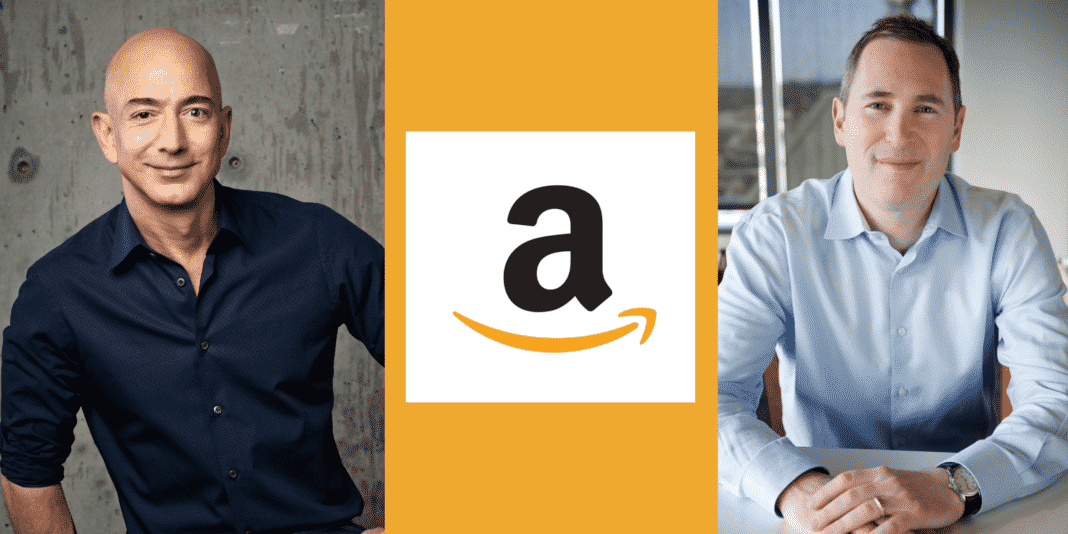In the business world nobody makes news like Amazon. But even by its own peripatetic standards, the first few weeks of 2021 have been particularly busy for the world’s largest ecommerce company.
The biggest Amazon bombshell would be its most recent – on February 2, Jeff Bezos announced that he would step down as CEO of the company he founded in 1994 and will become executive chair. Replacing him will be Andy Jassy, currently chief executive of Amazon Web Services (AWS), the Seattle-based firm’s most successful business unit. The change is planned for the company’s third quarter.
Bezos said that he will stay engaged in important Amazon initiatives but wants to spend more time and energy on other areas, including the company’s Day 1 Fund that supports non-profits; the Bezos Earth Fund that focuses on clean energy and environmental equity; creating human spaceflight with Blue Origin; and The Washington Post, which Bezos purchased in 2013 for $250 million.
Jassy went to work at Amazon after graduating from Harvard Business School in 1997. Shortly after joining, Jassy took on the highly coveted role of technical assistant at Amazon and held the title for 18 months. He then held a variety of posts as the company grew and eventually laid the foundation for Amazon Web Services, the cloud computing business. The cloud business generated $45 billion in sales last year, up 30 percent from a year earlier.
The Bezos-Jassy announcement marks the second major executive transition at the company in the past year. Last August, chief executive of Amazon’s consumer business Jeff Wilke announced that he would retire in early 2021 after more than 20 years with the company. Dave Clark, who ran the company’s fulfillment and logistics operations, was promoted to replace him.
The Bezos announcement dovetailed with another robust financial performance. In its fourth quarter, ended December 31, net sales increased 44 percent to $125.6 billion, compared with $87.4 billion in the fourth quarter of 2019. Net profit for the quarter increased to $7.2 billion, compared to $3.3 billion a year ago.
Amazon’s 2020 net sales increased 38 percent to $386.1 billion, compared with $280.5 billion in 2019. Net income increased to $21.3 billion, compared with net income of $11.6 billion in 2019.
Amazon’s subscription service revenue, which includes Prime fees, grew 35 percent in 2020 compared with the previous year, to top $25 billion.
Meanwhile on the battle lines (Amazon’s fulfillment centers), employees at an Amazon.com warehouse in Bessemer, AL, began receiving ballots February 8 from the National Labor Relations Board (NLRB) to vote on whether or not to be represented by the Retail, Wholesale and Department Store Union (RWDSU). According to a New York Times report in January, more than 2,000 workers at the facility signed cards calling for a vote to unionize. Voting will continue through March 29.
And unlike most attempts to organize, wages and benefits are not the primary issues confronting Amazon. The big merchant already pays a starting wage of $15.30 an hour at its facility located near Birmingham which employs nearly 6,000 associates. It also offers dental, medical and vision insurance as well as a retirement plan and additional benefits.
However, employees complain that their job performance evaluations are based on unrealistic company-determined goals.
Regardless of the outcome of the vote, Alabama is a right-to-work state, so even if a majority votes to be represented, workers will still have the option of not joining the union. A Wall Street Journal report said that some workers it interviewed said they would likely not join the union.
Amazon has asserted that if workers do vote to join, membership will essentially take money out of workers’ pockets in the form of union dues. RWDSU’s organizing efforts have placed more focus on making Amazon workplace conditions based more on “respect and dignity.”
Some industry observers believe that if associates at the Bessemer distribution center vote to be represented by a union, that could have a ripple effect at Amazon facilities across the country, especially in light of the many complaints by Amazon workers during the COVID-19 epidemic of unsafe workplace conditions.
And there’s more negative Amazon news. On February 2, the Federal Trade Commission (FTC) announced that Amazon has agreed to pay $61.7 million to settle charges that it withheld tips to delivery drivers for nearly three years. The FTC said that Amazon secretly lowered hourly wages for Flex delivery drivers and used customer tips to cover for the lower pay. According to the FTC, Amazon promised its Flex drivers that they would receive 100 percent of all customers’ tips. But, starting in 2016, Amazon lowered hourly delivery wages, which were advertised at $18 to $25 per hour, without disclosing the changes to its drivers. Additionally, it tried to mask the lower wages by using customer tips to cover the difference, essentially meaning that workers received smaller overall take-home pay, said the agency.
Ultimately the Flex drivers noticed the compensation reductions and began to complain, leading Amazon to abandon the practice in 2019, after it became aware that the FTC was investigating it. The company settled without admitting wrongdoing.
“Rather than passing along 100 percent of customers’ tips to drivers, as it had promised to do, Amazon used the money itself,” said Daniel Kaufman, the acting head of consumer protection at the FTC. “Our action today returns to drivers the tens of millions of dollars in tips that Amazon misappropriated and requires Amazon to get drivers’ permission before changing its treatment of tips in the future.”
Flex workers are classified by Amazon as independent contractors and often use personal vehicles for deliveries of the company’s Prime Now and AmazonFresh items. Customers can tip delivery drivers on the checkout page.
The FTC’s investigation is part of growing scrutiny by the federal government of the treatment of contract workers, who are a growing portion of the workforces of big tech companies such as Amazon, Google and Facebook.
More locally, Amazon submitted plans seeking county approval for the second phase of development for its Arlington, VA (Crystal City) headquarters (HQ2).
Highlighting the plans is a futuristic 350-foot-tall building modeled after a double-helix that will serve as the centerpiece of a $2.5 billion headquarters campus that Amazon said will emphasize sustainability, featuring environmentally friendly buildings that maximize natural light and eventually would rely entirely on solar power for energy (employees would be able to open windows if they want).

More than three years after Amazon announced it would expand beyond its current Seattle headquarters, construction at the Virginia site is well under way. Dubbed Pen Place, the newly unveiled proposal for the second phase of the plan will provide an additional 2.8 million square feet of office space in three 22-story buildings.
The site’s focal point will be “The Helix,” a tree-covered glass structure where a series of “alternative work environments” will be set amid indoor gardens and greenery. According to NBBJ, the architectural firm behind the project, a spiral “hill climb” will allow employees and visitors to ascend the outside of the structure. “The Helix” will be open to the public occasionally, but other parts of the campus are intended for regular use by the community.
The new proposal includes 2.5 acres of public space across the Potomac River from Washington, DC containing art installations, communal grassy areas and a 250-seat amphitheater. Outdoor plazas will host mobile food vendors and farmers’ markets while retail space will include shops and restaurants at ground level.


